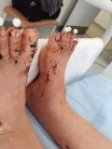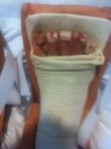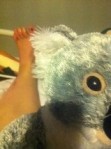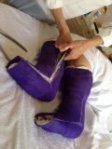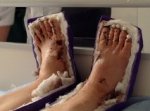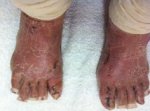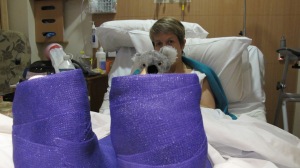Hello Everyone!
Your responses to my blog postings have been so heartfelt, and it has been so long since my last post, that I felt compelled to write an update.
It has been a challenging ride to get here – the outcome of the operation has definitely not been an all-rosy experience. I have had some real lows in relation to the varying results I have had.
The Good
I can still fit into more shoes than I used to be able to; my arches have remained lower than prior to the surgery.
My ankles are straight and that means I now feel comfortable wearing skirts and dresses.
I don’t tend to fall over as my arches are neutral, no longer supernated (walking on the outside of the foot).
I walk with more of a heel-ball-toe motion in my feet.
My feet look prettier!
The Bad
My walking is slow and I walk consciously; that is, it takes me energy to just think about walking. Dr Grace Warren would suggest that the surgery would mean that I would ‘forget’ about walking. Not so at all!
Balancing on one foot is still rubbish – I just can’t do it for a sustained period.
My ankles are still weak, and it is difficult to walk on uneven ground. Hikes with lots of tree roots or rocks are not an option.
My big toes droop. Part of the surgery involved straightening all of my toes to relieve the clawed, hammer toes. Dr Andrew Ellis put metal rods in my two big toes, which makes them heavier. The result is that the new tendon, which has weakened since surgery, cannot lift my big toes. When in bare feet, I often trip on my right toe. It is near impossible to walk on the beach in bare feet without tripping on my toe.
The Ugly
One of the worst outcomes of surgery is that the tendon transfer (from the bottom to the top of my feet) did not ‘take’; that is, my CMT ( Charcot Marie Tooth) condition meant that the new tendon, which pulls the foot upwards when walking, was weakened by the disease. The aspect of walking that is still challenging is pulling my feet up, and means my gait is a bit awkward and laboured.
My calves and hamstrings are VERY weak! This is a direct result of being in casts for two, 6-week periods for the surgeries. I cannot stand on my toes, my gait is slow because of my weak muscles, and it is particularly difficult for me to climb stairs – I have to use the handrail to pull myself up.
To this day, I do not understand why I was not advised that the CMT would compromise my muscles during the time they were not in use for those two long periods of time. As Dr Ellis explained to a frustrated me following the operation: “People with CMT have muscles that run out of gas much faster than for people who do not have the condition.”
So WHY – oh why – did he not advise me that the time in casts would weaken my muscles, permanently, it would seem?
My Summary
So, with all the negatives of the surgery results, am I happy that I had the surgery? Would I do it again, presented with the option?
I have thought about these questions a lot. In my darkest days, the surgery was a mistake. I would agonize over my walking and my stair-climbing abilities. Much more than spending the 25K on the two surgeries, I felt that I had ruined my feet. I believed that the negatives definitely outweighed the benefits.
Today, with my sunny disposition back, I am glad I had the surgery. There are many negatives, but it was not a mistake. I do walk better, and I am vain, so I appreciate being able to wear the skirts and dresses.
I hope this posting helps all of you who are considering undergoing surgery. Be sure to ask your doctor all of the difficult questions, and be prepared for more hard work that they suggest.
And please keep your comments and questions coming – I love the feedback, and knowing that I’m helping people with similar struggles!
All the best, Christa

